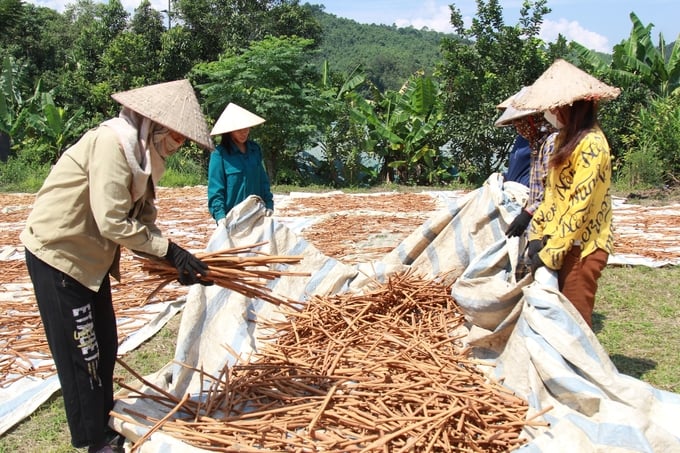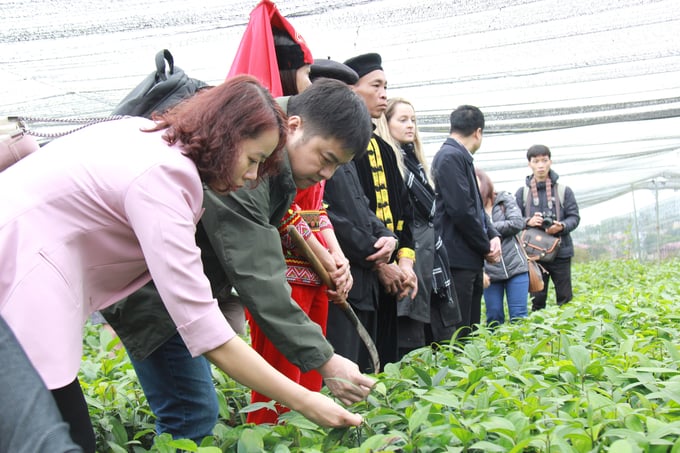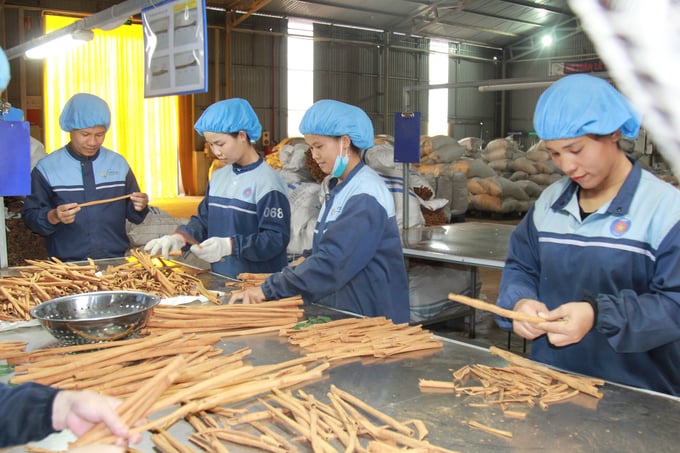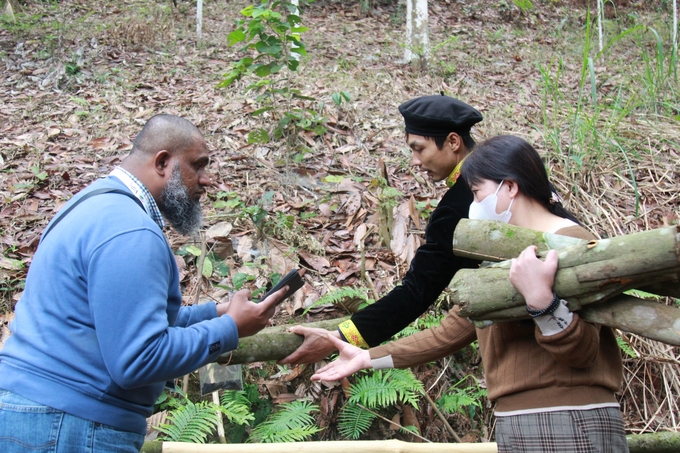May 20, 2025 | 17:44 GMT +7
May 20, 2025 | 17:44 GMT +7
Hotline: 0913.378.918
May 20, 2025 | 17:44 GMT +7
Hotline: 0913.378.918

The movement for organic cinnamon production is increasingly embraced by the residents of Van Yen district. Photo: Thanh Tien.
The organic cinnamon production movement in Van Yen district of Yen Bai province, which is the largest "cinnamon market" in Vietnam, has been in full swing for some time. The district has established a concentrated cinnamon planting area in the organic orientation on a 35,000 ha area. The cinnamon area with international organic certification has reached 11,000 ha and is expected to increase to 15,000 ha by the end of 2024.
In addition to the significant involvement of local authorities, scientists, and active support from enterprises, farmers' mindsets regarding organic cinnamon production have evolved.
The company conducts regular training courses for farmers on cultivation practices, the creation of high-quality products, and the enhancement of the value of the products, according to Le Van Long, the project manager of Son Ha Spice Flavorings.
In addition, the organization implements a distribution system in each village to facilitate the trading environment for the populace, as well as offering producers training in the area of quality evaluation. In addition to trading, they also provide direct communication and guidance to producers to ensure the production of high-quality products.

Enterprises cooperate with local authorities to encourage households to cultivate cinnamon using organic methods. Photo: Thanh Tien.
The company invests in infrastructure facilities and contemporary equipment systems at the processing plant to improve the quality of the products. Van Yen cinnamon material areas that are underwritten by the company are currently certified under the American Standard Organic and sustainable agriculture standards. These are relatively high standards in the agriculture sector. Son Ha Spice Flavorings has presently established a large organic cinnamon area, collaborating with approximately 11,600 farming households. 6,000 ha of this area have been certified to meet US and EU standards.
The company ensures sustainable development by establishing a linking chain that extends from agricultural households to local authorities and enterprises, as well as the distributor system. Initially, the organization provides farmers with training and guidance on the principles of organic cinnamon production, from the hills to the processing plants. This includes instruction on the harvest, preservation, and transportation of the product to prevent cross-contamination and the occurrence of mixed organic standard and organic substandard products during the harvest, transportation, and preliminary processing.
In particular, the organization offers farmers incentives for producing high-quality products that can be sold to the facility. The company distributes reward cash to producers in the project area on an annual basis, with a range of 3 to 5 billion USD.

Son Ha Spice Flavorings Co., Ltd. has additional reward policies for farmers who produce high-quality cinnamon. Photo: Thanh Tien.
Additionally, some initiatives provide producers with the essential resources to produce high-quality products. For instance, each agricultural household will receive a complimentary supply of chemical-free packaging and white fasteners to facilitate the production of cinnamon without the risk of chemical cross-contamination. They also conduct social welfare activities regularly, provide free check-ups and medicine distributions to farmers, and support pure water tanks.
The company dispatches its trade staff to each household and provides training to all distributors. Additionally, the company conducts an annual internal assessment to determine whether they can inspect product quality.
The current cinnamon export market has been more stringent, particularly in demanding markets such as the United States and the European Union, according to Le Van Long. The input quality criteria for lower markets, including the Middle East, India, and China, have become more stringent.
The cinnamon production industry is currently confronted with two primary concerns: the heavy metal content in the products and the residual compounds. As a result, businesses must work in close collaboration with local authorities to provide farmers with regular guidance on pest management and to prevent the use of banned pesticides when using pesticides and other chemicals on cinnamon. It is imperative to organize the raw material areas to prevent cross-contamination between households that engage in organic production and those that do not.

The export market for cinnamon is becoming increasingly demanding, making organic cinnamon cultivation the inevitable path. Photo: Thanh Tien.
This is a substantial concern for both local authorities and enterprises to heavy metal residue. Therefore, it is imperative to collaborate in the development of a comprehensive research project that will reduce the presence of heavy metals in cinnamon products. This will result in the development of technical solutions that will assist and instruct farmers in the implementation of production processes that adhere to industry standards. Sustainability in the export of the products can only be accomplished through this method.
Mr. Pham Trung Kien, Vice Chairman of the People's Committee of Van Yen District, stated that the district's objective is to further enhance the quality and quantity of cinnamon products by progressively focusing on high-demand markets to increase the income value for the population.
According to Mr. Kien, the expansion of the organic cinnamon material area to comply with international standards and certifications is a long-term process that involves the selection of varieties, intensive cultivation, care, and preliminary processing. Households and production areas that have been granted organic certification are required to undergo a rigorous sampling and testing procedure for buffer zones, soil, water, cinnamon bark, and leaves.

Van Yen district strives to have 35,000 hectares of organic cinnamon by the end of 2025. Photo: Thanh Tien.
An independent unit will conduct testing to issue certifications, and the province of Yen Bai will completely support the costs of hiring a consulting unit to handle this process. Furthermore, certain organizations have entered into agreements with residents to cultivate organic cinnamon material areas for export.
At present, households are directly granted organic certification. Nevertheless, collective certification is required for organic cinnamon that is introduced into the US and EU markets by 2025. Consequently, the demands for cinnamon material areas will be greater, necessitating the collaborative coordination of all households in a production area rather than individual households.
Van Yen District will persist in developing and expanding the organic cinnamon material area in the district by utilizing programs and policies such as Resolution No. 69 of the Yen Bai Provincial People's Council and national target programs in the future. This will establish advantageous circumstances for cooperatives and businesses to survey and construct organic cinnamon material areas for export.
Translated by Linh Linh

(VAN) Japan's grant aid project contributes to capacity building, promoting organic agricultural production, and fostering sustainable community development in Dong Thap province.

(VAN) For years, the CRISPR-Cas9 genome technology has been reshaping genetic engineering, a precision tool to transform everything from agriculture to medicine.

(VAN) Vietnam aims to become a 'leader' in the region in the capacity and managing effectively soil health and crop nutrition.
![Reducing emissions from rice fields: [Part 1] Farming clean rice together](https://t.ex-cdn.com/nongnghiepmoitruong.vn/608w/files/news/2025/05/05/z6509661417740_a647202949c539012a959e841c03e1d3-nongnghiep-143611.jpg)
(VAN) Growing clean rice helps reduce environmental pollution while increasing income, allowing farmers to feel secure in production and remain committed to their fields for the long term.
/2025/05/19/5136-1-144800_230.jpg)
(VAN) The Nghe An Provincial People's Committee has just approved the list of beneficiaries eligible for revenue from the Emission Reductions Payment Agreement (ERPA) in the North Central region for the year 2025.

(VAN) 14 out of 35 domesticated elephants in Dak Lak province have had their living conditions improved, with 11 of them currently participating in the non-riding elephant tourism model.

(VAN) Muong Nhe Nature Reserve hopes that being upgraded to a national park will lay the foundation for forest protection efforts to be carried out in a systematic, modern, and sustainable manner.